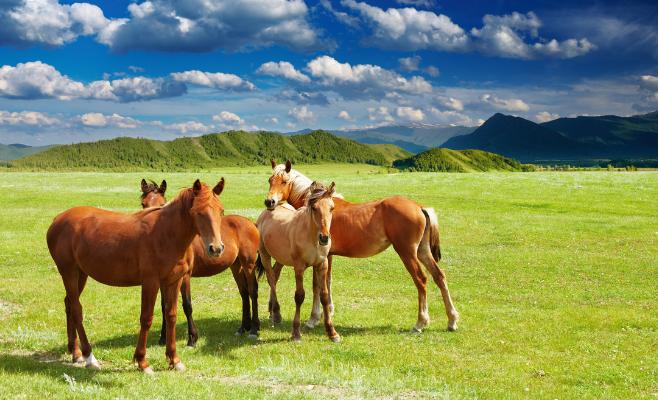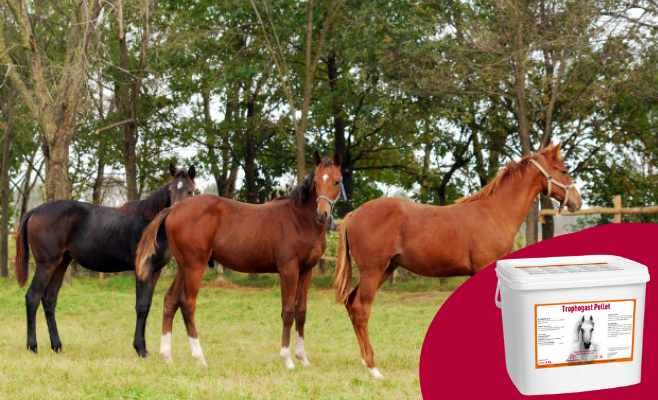
Resume Sports Activity: 3 Equiplanet Tips
19 February 2021
Colts and Fillies taming and training: 7 nutritional tips
17 May 2021Yearling Period: Balanced diet for best development in the first year of horse life

As already mentioned previously, the development of the foal and the attention we must take to its nutrition starts from the moment it is still a conception moment, before it is born. During the first year of life, the average weight gain is approximately one kg per day is is why a correct balance between the different nutrients is essential for optimal development. Nutritional mistakes in this phase can compromise the yearling’s harmonious growth and future racing career. Let’s find out together how to deal with the yearling’s first year of life:
Yearling period: how to manage it:

Weaning foal nutrition between 5 and 7 months:
Most foals are weaned between 5 and 7 months of age. During the first few months they are fed only with the mare’s milk and by 4 months the weanling foal begins to ingest forage. Milk production slows down slightly and from this point forward, the weaning foals begin to take up the feed given to the mare. At this stage, it is necessary to pay attention to the feeding of the mare, as described in our previous article
How and how much does a yearling grow in its first year?
Since weaning, a foal’s daily weight gain averages 700-400 g per day and decreases as it gets older. Height growth averages 2 centimetres per month at the withers. After one year of age and until it reaches adulthood, growth continues at a more moderate rate: 150 to 300 g per day.

Yearling’s growth rate
The yearling’s growth rate is strongly influenced by the diet, especially the amount of energy and protein given. At 12 months, the yearling has reached about 65% of its adult weight and more than 90% of its height. At 18 months, the weight is about 75% of the adult weight and the height is the 95%. Feeding is therefore crucial from weaning onwards and it is necessary that the growth rate is constant, without falls or peaks, to avoid an increased risk of abnormalities in skeletal development.
Energy and protein needs of yearling
Perhaps the most important piece of information to focus on, is that despite their small size, weaned foals have enormous nutritional requirements due to the demands of growth. According to the National Research Council’s Nutrient Requirements of Horses, a 6-month-old weaned foal with an expected adult weight of 500 kg has a digestible energy (DE) requirement of 16.5 MCal per day and a protein requirement of 676 g. To get an idea of these numbers, consider that a 500kg adult horse for maintenance needs 16.7 MCal per day of DE and 630g of protein. Therefore, even though a weaned foal does not even weigh 225 kilograms, its caloric and protein needs are the same as a mature horse that is twice its size.
The nutritional needs of the foal can be found in this table:
| Growing stage | Weight (kg) | De (Mcal) | CP (g) | Lysine (g) | Ca (g) | P (g) |
| 4 months | 170 | 13.30 | 669 | 28.80 | 39.10 | 21.70 |
| 6 months | 210 | 16.50 | 676 | 29.10 | 38.60 | 21.50 |
| 12 months | 320 | 18.80 | 846 | 36.40 | 37.70 | 20.90 |
Forage in growing foals
After 6 months of age, weaning foals eat much more independently and are able to handle larger quantities of forage. Foals are born with a back gut that lacks a complete set of enteric microflora, it’s why they are not able to fully utilise complex forages as adult horses do.

Intestinal function progresses with the foal’s age. Furthermore, foals are born without teeth and while deciduous premolars appear in the first few weeks, molars do not appear until the yearling is 9 to 15 months old. The animal’s ethology, immature intestine and early teething are reasons for considering that weaning should not take place before 6 months of age. The hay should be of high quality, and alfalfa should also be taken into account for its good protein and calcium content, but should not exceed 30% of the feed ration.
Concentrates, balancer and complementary feeds in growing foals
Typically, commercial diets formulated for horses are relied upon for feed. Cereals used in equine nutrition are deficient in some essential amino acids, including lysine.

What growing foals need is a good quality and bioavailable source of protein that is especially high in lysine. Diets that are too high in carbohydrates may contribute to problems with skeletal development. We recommend that a complementary feed such as Mac Breed is introduced into the weaned foal’s diet. Mac Breed provides 20,000 mg/kg lysine and, due to its composition, helps to avoid nutritional deficiencies and allows for a balanced ration.
Minerals and Vitamins in the first year of life of growing foal
Minerals and vitamins are essential for growth, especially as mother’s milk contains low amounts of zinc and copper and after weaning these minerals must be taken through the solid diet. Field studies have revealed a negative correlation between dietary copper concentration in weaned foals and the incidence of skeletal abnormalities, supporting a direct relationship between reduced copper intake and lower collagen quality, leading to cartilage problems.
Vitamin A is important for skeletal organisation, and insufficient dietary intake of vitamin A results in damage to cartilage growth. In addition, calcification proceeds but in a disorderly fashion with shorter, thicker and more deformed bones, predisposing to alterations in tendon physiology.

Vitamin D deficiency also has disastrous consequences for skeletal development: stunted growth, poor calcification, enlarged joints and bone deformities. A mineral feed that provides amino acids, vitamins and minerals essential for the weaned foal’s growth is Osteo foal.
What if I buy the yearling by someone else?
It can be important to ask the breeder what the yearling was fed on and continue with the same feed, at least until it is well adapted. The same applies to hay: ask if you can take or buy a bale of hay from the breeder so that you can make this transition slowly as well. Weaning, housings and changes of owner are such stressful events for the foal that it would be advisable to always give a complementary feed that supports normal gastric physiology such as Trophogast pellets.

Yearling: Access to the paddock
Access to the paddock has 2 fundamental functions in the growing horse: the first is of a nutritional nature because it allows him to consume feed on a constant basis while respecting his physiology, the second concerns the possibility of moving freely in a large space. This is essential for the development of the skeletal system, in particular the limbs and hoof. If you wish to further support the foal’s skeletal system from a nutritional point of view, you can supplement the diet with complementary feeds containing in particular Msm, Glucosamine and Lysine, such as Artro Gag.

As we have seen together, a poorly balanced diet with excesses or deficiencies, can predispose to alterations in the normal skeletal construction of growing foals. The resulting damage prevents yearlings from expressing their full genetic potential as adults in terms of height, weight and performance.
If you have any doubts about how you are managing your growing foals’ rations, please write us an email for any further advices – info@equiplanet.it
Stay tuned, follow us on Instagram
BIBLIOGRAPHY
- The effect of dietary energy source on serum concentration of insulin-like growth factor-I growth hormone, insulin, glucose, and fat metabolites in weanling horses. J K Ropp, 2008
- The incidence of abnormal limb development in the Irish thoroughbred from birth to 18 months. D D O’Donohue, 1992
- Effect of copper supplementation on the evidence of developmental orthopaedic disease in pasture-fed New Zealand Thoroughbreds. S G Pearce, 1998
- Studies on serum selenium and tocopherol in white muscle disease of foal. T Higuchi, 1989
- Disorders of calcium and phosphate metabolism in horses Ramiro E Toribio, 2010
- Influence of specific management practices on blood selenium, vitamin E, and beta-carotene concentrations in horses and risk of nutritional deficiency, 2020
- Feeding management in italian quarter horse centers. D. Gatta, 2002
- Crescita dei puledri e proposta di una diversa valutazione grafica L Magni, 1997
- What Does My Weanling Need to Eat? C Thunes, 2019
- Feed Weanlings Carefully to Support Growth, Reduce DOD. N Liburt, 2017

